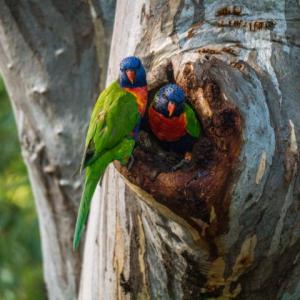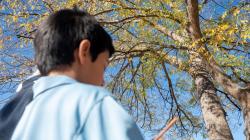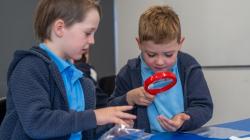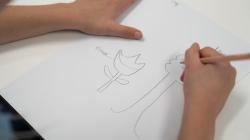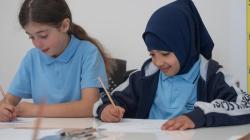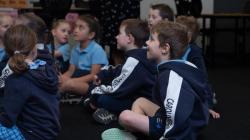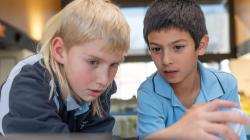'Survive and thrive' is one of our new teaching sequences for AC V9
- On the 'Sequence overview' tab you'll find all the lessons in this sequence and curriculum alignment.
- The 'Our design decisions' tab shows how key scientific ideas develop over the sequence, and shows how the sequence addresses curriculum achievement standards.
- The 'Preparing for this sequence' tab guides you through important information and considerations for this sequence.
- Have you taught this sequence? Use the Feedback button to let us know how it went!
Launch
Lesson 1 • Living in the schoolyard
Students participate in a plant and animal observation walk, record their findings and develop investigation questions about the needs of plants and animals.
Inquire
Lesson 2 • Investigating plant growth
Students investigate the growth of plants by planting seedlings. They also develop a method for tracking plant growth.
Lesson 3 • Watering deep
Students conduct an experiment to understand how plants absorb water, and continue their ongoing observations of their seedlings.
Lesson 4 • Move with the sunlight
Students examine how plants move to receive more sunlight, and continue their ongoing observations of their seedlings.
Lesson 5 • Animal needs—space and shelter
Students identify and compare the needs of an animal to their own needs. They explore the importance of adequate space and shelter.
Lesson 6 • Animal needs—food, water, air
Students compare a peregrine falcon's diet to a human's, and why animals move around to find what they need to survive. The investigate what happens to an animal's body as it moves, with a focus on the need for air and water.
Lesson 7 • Food and fibre (optional lesson)
Students explore how humans use food and fibre to stay alive, considering the numerous products that come from sheep and identifying other sources for products that humans use. Students examine the needs of sheep and draw conclusions about the needs of all animals.
Act
Lesson 8 • Communicating learning through dioramas
Students consolidate their learning by identifying the features in various habitats that help plants and animals to survive, then design and make a diorama to share with a selected audience.
The Australian Academy of Science supports and encourages broad use of its material. Unless indicated below, copyright material available on this website is licensed under a Creative Commons Attribution-NonCommercial-ShareAlike 4.0 International (CC BY-NC-SA 4.0) licence.
Curriculum and syllabus alignment
Achievement standards
By the end of Year 1 students identify how living things meet their needs in the places they live. They describe situations where they use science in their daily lives and identify examples of people making scientific predictions.
Students pose questions to explore observations and make predictions based on experiences. They follow safe procedures to make and record observations. They use provided tables and organisers to sort and order data and information and, with guidance, represent patterns. With guidance, they compare observations with predictions and identify further questions. They use everyday vocabulary to communicate observations, findings and ideas.
Australian Curriculum V9 alignment
Science as a human endeavour
Describe how people use science in their daily lives, including using patterns to make scientific predictions
Science understanding
Identify the basic needs of plants and animals, including air, water, food or shelter, and describe how the places they live meet those needs
Science inquiry
Pose questions to explore observed simple patterns and relationships and make predictions based on experiences
Sort and order data and information and represent patterns, including with provided tables and visual or physical models
Compare observations with predictions and others observations, consider if investigations are fair and identify further questions with guidance
Write and create texts to communicate observations, findings and ideas, using everyday and scientific vocabulary
Australian curriculum content links
| Science understanding core concept: Biological systems are interdependent and interact with each other and their environment. |
| Sub-strand | Content descriptor | AC code | Achievement Standard | How the sequence addresses this content |
| SHE: Use and influence of science | Describe how people use science in their daily lives, including using patterns to make scientific predictions. | AC9S1H01 | Describe situations where they use science in their daily lives and identify examples of people making scientific predictions. | Recall previous personal plant and animal experiences and observations and the importance of using senses for observation. (Lesson 1) Identify their own personal needs for survival and compare those to pets, class pets/peregrine falcons, sheep and other animals. (Lessons 5-7) Predict and describe changes that occur to their body during movement/exercise. (Lesson 6) Identify numerous products in their everyday lives that are sourced from food and fibre production including products that come from sheep. (Lesson 7) |
| SU: Biological sciences | Identify the basic needs of plants and animals, including air, water, food or shelter, and describe how the places they live meet those needs. | AC9S1U01 | Identify how living things meet their needs in the places they live. | Identify the basic needs of seedlings, pets, class pets/Peregrine falcons, sheep and other animals. (Lessons 1-8) Identify the features of the places plants and animals live (habitats) that help them to grow and stay healthy. (Lessons 1- 8) Recognise humans as animals and compare our needs to other animals. (Lessons 1, 5-8) Recognise the importance and diversity of food and fibre production for human survival. (Lesson 7) |
| SI: Questioning and predicting | Pose questions to explore observed simple patterns and relationships and make predictions based on experiences. | AC9S1I01 | Pose questions to explore observations and make predictions based on experiences. | As a class, develop a set of inquiry questions about the needs of plants and animals. (Lesson 1) Record plant investigation predictions as teams/pairs. (Lesson 2) Contribute to discussion and predictions about the needs of plants and animals. (Lessons 2-7) |
| SI: Planning and conducting | Suggest and follow safe procedures to investigate questions and test predictions. | AC9S1I02 | Follow safe procedures to make and record observations. | Explore the scientific method to set up a safe and fair test on the needs of plants, and gather evidence to answer questions. (Lesson 2) Help to develop a code of conduct and pet care roster for the class pet. (Lesson 5, optional) |
| SI: Planning and conducting | Make and record observations, including informal measurements, using digital tools as appropriate. | AC9S1I03 | Follow safe procedures to make and record observations. | Record observations of plants and animals using science journals and photographs. (Lessons 1-7) Record plant growth using popsticks. (Lesson 2-4) Observe and discuss a time-lapse video of seedlings moving towards the sun. (Lesson 4) |
| SI: Processing, modelling and analysing | Sort and order data and information and represent patterns, including with provided tables and visual or physical models. | AC9S1I04 | Use provided tables and organisers to sort and order data and information and, with guidance, represent patterns. | Record findings of investigations as a class in the class science journal or individually (and in pairs) in the individual science journal. (Lessons 2-8) Complete a labelled diagram showing how plants absorb water. (Lesson 3) Graph plant growth data and human water consumption. (Lessons 4, 6) |
| SI: Evaluating | Compare observations with predictions and others’ observations, consider if investigations are fair and identify further questions with guidance. | AC9S1I05 | With guidance, compare observations with predictions and identify further questions. | Record plant growth predictions and compare with results. (Lessons 2, 4) Create a T-chart to compare the food eaten by the class pet/peregrine falcon to people, as a class. (Lesson 6) Create two Y-charts to record observations of how humans look, feel and sound before and after exercise, as a class. (Lesson 6) Discuss findings to reach consensus on animals’ needs. (Lessons 6, 7) |
| SI: Communicating | Write and create texts to communicate observations, findings and ideas, using everyday and scientific vocabulary. | AC9S1I06 | Use everyday vocabulary to communicate observations, findings and ideas. | Verbally share observations, ideas and understanding about the needs of plants and animals. (Lessons 1-8) Design and create a labelled habitat diorama. (Lesson 8) Complete an explanatory sheet My Scientific Diorama. (Lesson 8) |
| Design and Technologies: Food and fibre production | Explore how plants and animals are grown for food, clothing and shelter. | AC9TDE2K03 | Describe the purpose of familiar products, services and environments. | Sort and match a range of food and fibre items to their source. (Lesson 7) Explore how humans use food and fibre products from sheep. (Lesson 7) |
Science journals
Create a class science journal, either in hard-copy or digitally. You might:
- use/create a large scrap book or flip chart.
- use poster/butchers’ paper so learning can be displayed in sequence on the wall.
- create a digital journal using your platform/ technology of choice.
- any combination of the above.
Plan for students’ creation of an individual science journal, either in hard-copy or digitally. They might:
- use an exercise book, scrap book or flip chart to record their thinking and gather resource sheets together.
- use a folder to store and collate resource sheets, diagrams, photographs etc.
- use a digital folder to store work samples, images and videos.
- any combination of the above.
See Using a science journal throughout inquiry for more detailed information on the importance of science journals.
General preparation
- Read through the teaching sequence.
- Prepare demonstration copies of Resource sheets as required.
- Prepare student copies of Resource sheets as required.
- Determine if you will teach Lesson 7 Food and fibre (optional lesson). This lesson explores how humans use animals, in this instance sheep, to meet human needs for food and fibre. It is a good opportunity to link to Design and technologies. However, it might be considered an extension to the science concept, as it explores how humans design their habitats to meet their needs. It may be omitted due to time constraints, or if the Design and technologies content has been met in a different context.
- Print, laminate and cut out the cards from the Food and fibre match-up Resource sheet, from Lesson 7 (optional lesson) if needed.
- Note any adaptations you would like to make to suit your school and students’ context, including lessons you may choose to run across more than one session, for example Lessons 2 and 8.
- Determine if you would prefer or have the resources for students to observe a live animal, rather than observing the peregrine falcons via the FalconCam Project YouTube channel. Check your school and systems policies regarding keeping live animals in the classroom or school grounds and plan accordingly. Further information below.
- Consider setting up an area in the classroom where you can build a 'nature table' over the course of the sequence. This 'table' will be a place to collect specimens of plants and animals as appropriate, or images of plants and animals. It can be used to spark conversation and curiosity about plants and animals.
- Consider how students will determine the plant or animal they are making their habitat diorama for, as is appropriate for your students and context. Students may be given free choice, asked to select from a predetermined list of familiar plants or animals, or the class may all create a habitat for the same plant and/or animal.
- Consider the type of diorama students will make and begin collecting appropriate resources. See the embedded professional learning Adapting for your context—dioramas in Lesson 8 of this sequence for further information and ideas. Further information is also available below.
- Determine how students will share their dioramas and the audience they will share with. Some suggestions are:
- organising a gallery walk within the classroom for other classes or buddies.
- creating a display in a communal space such as a library/hallway
- involving the broader community during an open day, special person’s day or local show.
Plant preparation
Lessons 1-4 involve the use of seedlings (seeds that have already been germinated, undergone some period of growth, and have visible, if still establishing roots) and celery to study plants. The following preparation is required:
- 1 x healthy seedling for teacher demonstration
- 1 x unhealthy seedling for teacher demonstration
- To prepare for this you might withhold water from a seedling until its leaves begin to droop. The time for this will vary according to the temperature and heating/cooling used in the classroom.
- 2 x seedlings per group for student investigation, required from Lesson 2 (see further information below).
- Celery stem with leaves attached, in water with food colouring (Lesson 3 only)
Buying seedlings
Seedlings are seeds that have already been germinated, undergone some period of growth, and have visible, if still establishing roots. You can buy seedlings from a local garden centre and large hardware retailers.
The benefits of using seedlings include:
- less risk, as seeds are already germinated and plants are established.
- students will be able to measure growth in a shorter timeframe.
- students will be able to see the impact of their variable on their seedling in a shorter timeframe, thus supporting them to answer the investigation questions more easily.
This method requires less preparation but is more costly.
Obtain the seedlings just before the investigation and provide all groups with the same seedling type. Seedlings should be approximately 4-5cm in height before the students begin the investigation.
Growing from seed
We recommended using seedlings, rather than seeds, for this investigation. However, you might prefer to grow from seed, or budget requires you to do so.
The benefits of germinating seeds yourself include:
- it's likely to reduce costs.
- the ‘overcrowded’ pot can easily and deliberately be planted with too many seeds.
The challenges of germinating seeds yourself include:
- seeds need to be germinated well in advance of the investigation.
- seeds need to be provided with adequate water and warmth during germination, then sunlight during the growth stage.
- germination is not guaranteed.
If using seeds, allow sufficient time for the seeds to germinate and grow to approximately 4-5cm before the students begin the investigation. Seeds from gardening stores are more likely to germinate relatively quickly and consistently than seeds collected from the environment. This is because they come from plants that have been bred to produce seeds that germinate easily and/or they have been treated to encourage germination. The length of time it takes to grow a seedling to 5cm will vary between varieties, for example sunflower (7-12 days,) radish (5-8 days.)
Selecting the seedlings or seeds that are best for classroom growing conditions
Plant germination and growth depend on the requirements of the specific plant and its environment. Most plants tolerate some variability in their environment, such as high and low temperatures, over the course of a day and/or a year. The closer conditions are to optimal for a particular species, the more likely they are to grow rapidly (compared to similar plants in different conditions) and/or flower more rapidly and more abundantly.
Factors such as your location in Australia, and the time of year you are planting will impact which seedlings are the best choice to grow. Resources such as those listed below will help you find information to make decisions.
ABC's Gardening Australia: Vegetables and Herbs
Veggie Sowing Calendar By Australian Climate Zone
Animal preparation
Lessons 5-7 study the needs of animals and require access to the FalconCam Project YouTube channel to observe the peregrine falcons living on the Charles Sturt University campus in Orange, NSW.
Sensitivity warning
When viewing the FalconCam Project's YouTube channel live, be aware that the falcons may be eating, and that the main component of their diet is smaller birds. This means that students may be exposed to the falcons bringing birds back to their nest, consuming them, and, at certain times of the year, feeding them to their chicks. Many of the pre-recorded videos also involve the falcons consuming their prey.
Consider if this content is appropriate for your students, or what discussions you might need to have before viewing the video content. Always check the live feed privately before allowing students to view it.
Alternative to observing the peregrine falcons
Alternatively students might observe a live animal in the form of a class pet. Some suggestions might include fish, hermit crabs, lizards or meal worms.
Each Australian state and territory has animal ethics requirements for school investigations involving vertebrate animals (those with a backbone such as birds or guinea pigs). You would need to comply with any requirements of the relevant Animal Welfare Act if you chose to investigate vertebrate animals. Insects and crustaceans are invertebrate animals and are not covered by the Animal Welfare Act but still require care and consideration.
Each school and state might also have policies in place addressing animal welfare in classroom settings. Consult and follow the relevant policies.
Lungworm risk mitigation
A variety of snails, slugs and planarians are suitable intermediate hosts of the rat lungworm, Angiostrongylus cantonensis. Human infection occurs following ingestion of raw snails, slugs or planarians, something young toddlers are particularly prone to do. Another possible source of human infection is through ingestion of improperly washed vegetables such as lettuce.
It is recommended that the following safety procedures be followed during this sequence:
- Wear gloves when handling any biological material.
- Always wash hands with soap and water after handling any biological material (particularly snails, slugs or their slime, and any vegetation such as vegetables or leaf litter), even after wearing gloves.
- When handling snails or slugs, keep hands away from the mouth, and clarify with students that they should never encourage, or dare anyone to eat raw snails or slugs.
Diorama decisions for the Act phase
- Consider whether students will be working individually, in pairs or as a whole class to make the diorama in the Act phase. Further information about types of dioramas students might build appears in the embedded professional learning Adapting for your context- dioramas in Lesson 7 of this teaching sequence.
- Consider whether the Year 1 students will pair with a student from another year level. In the Primary Connections Finding Features teaching sequence for Foundation students, students design and make an animal model. These models could be paired with a suitable Year 1 habitat diorama. For example, a Foundation student might make a model of a kangaroo, and the Year 1 student could design the Australian grassland habitat–displaying both the kangaroo and its habitat together. Senior students/buddies could potentially work collaboratively with the Year 1 students for the habitat construction as well.
- Consider how and where the dioramas can be shared with others. For example: in class for peers, in a communal space such as shared learning space for the broader school community, at a science fair or open day for parents/grandparents, at a local show/fete for the local community etc
- Decide whether the dioramas will be digital or physical. See Resource: ‘Diorama Samples.’ If the students are building physical dioramas, begin collecting materials such as cardboard, shoe boxes, paper towel tubes, popsticks, twigs, sand, dried flowers, weeds etc.
Incursions and excursions opportunities
This teaching sequence should be adapted to suit your context. The study of plant and animal needs lends itself to numerous opportunities, for example:
Incursions
- Invite local First Nations people to discuss the use and importance of plants and animals in the local area for survival.
- Invite a guest to discuss their role in the food and fibre industry, e.g. farmer, scientist, food and fibre delivery driver, shearer, café owner.
- Invite a guest to discuss the needs of the animals they care for, e.g. wildlife carer, dog sitter, doggy daycare provider, zoo worker, farmer.
- Keep monarch butterflies to observe their needs through their lifecycle, from caterpillar to chrysalis, adult butterfly to egg.
Excursions
- Local park, zoo, pond, national park, farm
Other considerations
Mathematics link
Consider extending the theme of plants by incorporating an investigation into place value with the reSolve Maths Year 1 sequence reSolve Garden.
The materials required for each lesson are listed on the lesson's page. For the full sequence resource list, download the Preparing to teach this sequence document below.
